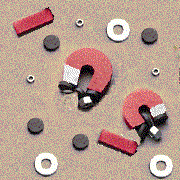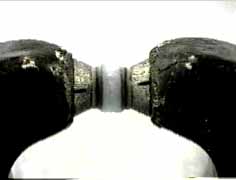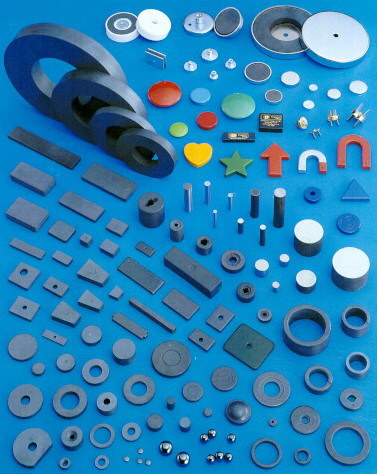 "What is Physics Good For?"
"What is Physics Good For?"
Extra credit is available at the end of this page. Please respond before 9 AM, Monday, October 23rd, 2000.

Magnetic Materials
For the next several weeks, we will be studying magnetic fields, and the forces that charged particles and currents feel as a result of these fields. However, we don't have enough time to cover magnetic materials in any detail. This is too bad for at least two reasons:
- Magnetic materials are an important technology that impacts our daily lives.
- Your instructor's research is in this area, and he is particularly fond of it.
This page will provide a VERY BRIEF introduction to the main types of magnetic materials, and to some of their uses.
 First, a technical point. All materials are magentic in the sense that they are affected by magnetic fields in some way. However, the extent to which they are affected varies widely. There are three categories that describe how a material is affected by a magnetic field. There are others, but these are the most basic.
First, a technical point. All materials are magentic in the sense that they are affected by magnetic fields in some way. However, the extent to which they are affected varies widely. There are three categories that describe how a material is affected by a magnetic field. There are others, but these are the most basic.
- Diamagnetism: Materials such as copper, lead, quartz, water, acetone, and carbon dioxide are diamagnetic. These materials are very weakly affected by magnetic fields. To the extent that they are affected, they become magnetically polarized in the opposite direction from the magnetic field. If the magnetic field is not uniform, they feel a force away from the higher field region.
Diamagnetism results from the the effects of magnetic fields on all of the electrons in the material. Thus, all materials are diamagnetic. However, the other forms of magnetism are stronger than diamagnetism, so the diamagnetism can usually be ignored unless it is the only magnetism present.
- Paramagnetism: Materials such as sodium, oxygen, iron oxide (FeO or Fe2O3), and platinum are paramagnetic. They are affected somewhat more strongly than diamagnetic materials, they become polarized parallel to a magnetic field. Thus, in a nonuniform magnetic field, they feel a force towards the higher field region.
Paramagnetism results from the magnetic forces on unpaired electrons. You may recall from a chemistry course that electrons move around atoms in "orbitals" and that a maximum of two electrons can go into each orbital. Electrons that are alone in an orbital are said to be unpaired.
- Ferromagnetic: Materials such as iron, nickel, gadolinium, iron oxide (Fe3O4), Manganese Bismuth (MnBi), and Cobalt Ferrite (CoFe2O4) are ferromagnetic. These materials are very strongly affected by magnetic fields. They become strongly polarized in the direction of the magnetic field, thus, they are strongly attracted to the high field region when the field isn't uniform. Furthermore, they retain their polarization after the magnetic field is removed. Once polarized, ferromagnetic materials produce magnetic fields of their own. Since these fields are usually not uniform (particularly near the ends of the piece) ferromagnetic materials are capable of attracting each other. All of the materials that you are used to calling "magnets" are ferromagnetic materials.
Ferromagnetism results from the interactions among the electrons in the material. This is why a ferromagnet can remain magnetically polarized even if there is no magnetic field applied to it from the outside.
It should be no surprise that most applications of magnetic materials call for ferromagnetic materials. These are the ones that interact most strongly with magnetic fields. Within this category there are several important subcategories. These have to do with how easily the magnetic polarization (magnetization) of the material can be changed.
In general, the more difficult it is to magnetize a material, the more that material will retain its magnetization. This property is known as "magnetic hardness."
For instance, in a (magnetically) hard material the magnetization is very difficult to change. However, the magnetized material will retain almost all of its magnetization once the magnetizing field is removed. Then, the material can used in this condition. Hard materials are ideal for use as "permanent magnets." Permanent magnets are used in many ways, the most familiar is probably the "fridge" magnet, which is often used to hold shopping lists and children's art to the refrigerator door. Permanent mangets are also used in magnetic catches (e.g., to keep the fridge door closed), in electric motors (there's another one in the fridge), in electric generators (which power the fridge), in anti-lock brakes, in electric guitar pick-ups, and in thousands of other common and unusual devices.
Ferromagnets that are very easily magnetized, but which give up most of their magnetization when removed from the magnetic field are known as soft magnetic materials. These materials are used in magnetic field sensors (to read the data on magnetic tape and disks, or in antilock brakes), and in magnetic shielding. They are also used in electric transformers, which we will learn about when we study aalternating current ciruits.
Between very hard and very soft materials, are those that can have their magnetization change with moderate difficulty, and which retain some or most of their magnetization. These materials are most frequently used as recording media. Both analog (cassette tapes, VHS movies) and digital recording (hard and floppy disks, DAT drives, digital video, etc.) use these materials.
You can get a lot more information about this subject on the internet. Here are a few search engines
1. Alta Vista
2. Google
3. Northern Light
4. Ask Jeeves
5. Infoseek
And here are a few good links to get you started.
1.  2.
2.  3.
3. 
- What is the origin of the term "Lodestone"?
- Name all of the elements that are ferromagnetic
- What is "coercivity"?
- How are magnets used in anti-lock brakes?
You may change your mind as often as you wish. When you are satisfied with your responses click the SUBMIT button.
This site is made possible by funding from the National Science Foundation (DUE-9981111).
©2001 A. Gavrin and G. Novak, all rights reserved.
|



 "What is Physics Good For?"
"What is Physics Good For?"
 First, a technical point. All materials are magentic in the sense that they are affected by magnetic fields in some way. However, the extent to which they are affected varies widely. There are three categories that describe how a material is affected by a magnetic field. There are others, but these are the most basic.
First, a technical point. All materials are magentic in the sense that they are affected by magnetic fields in some way. However, the extent to which they are affected varies widely. There are three categories that describe how a material is affected by a magnetic field. There are others, but these are the most basic.


